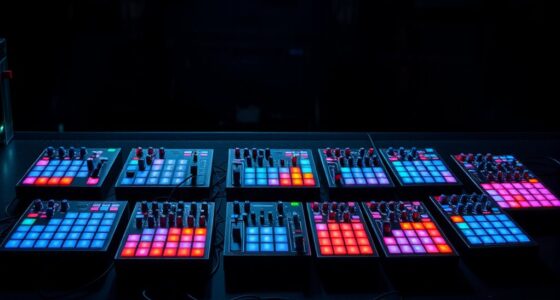If you’re looking for the best Mac minis for your home studio in 2025, I recommend considering models powered by the M4 and M4 Pro chips. These compact desktops offer impressive power with multi-display support, high-resolution outputs, and future-proof performance for demanding creative tasks. Their small size, quiet operation, and extensive connectivity make them ideal studio workhorses. Want to find out which options best fit your needs? Keep exploring for all the details.
Key Takeaways
- Compact, portable design with support for up to three high-resolution external displays suits diverse home studio setups.
- Powered by the M4 chip with 10-core CPU and GPU delivers around 20% performance gains for demanding creative tasks.
- Multiple connectivity options, including Thunderbolt 4, HDMI, and Ethernet, facilitate versatile device and workflow integration.
- Quiet operation and efficient thermal design ensure distraction-free, long studio sessions.
- Ideal for multimedia professionals needing space-efficient, high-performance desktops for editing, rendering, and multitasking.
Apple 2024 Mac mini Desktop Computer with M4 Chip
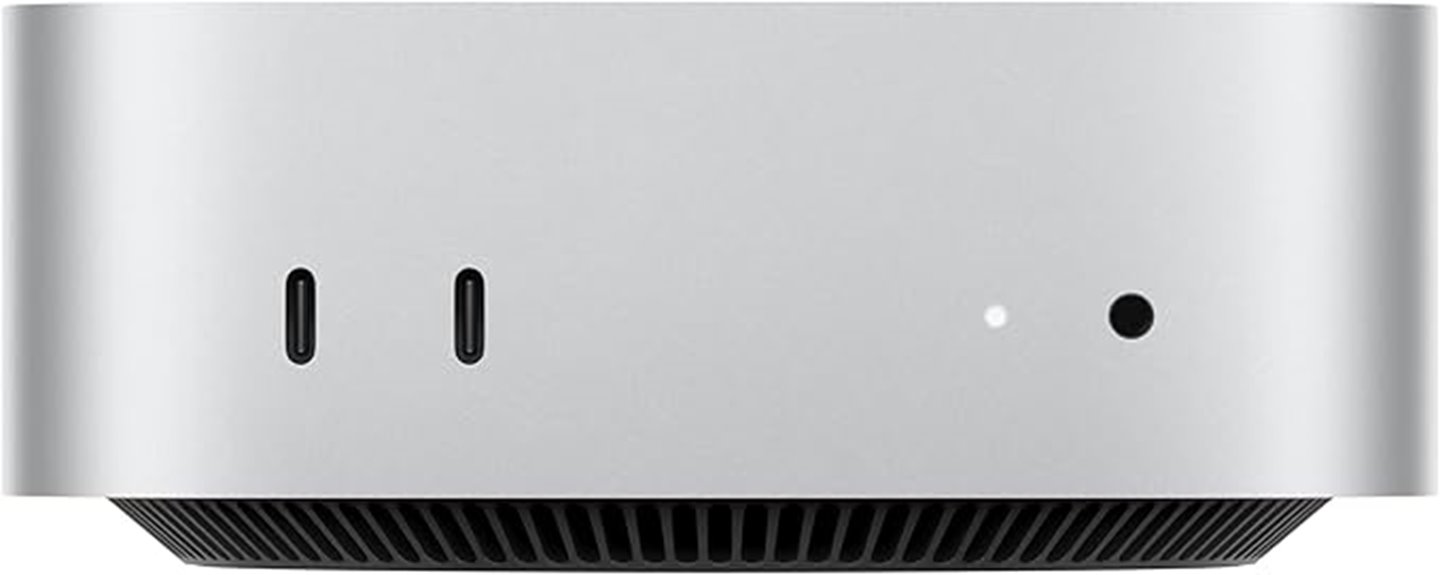
If you’re setting up a home studio, the 2024 Mac mini with the M4 chip is an excellent choice because it combines compact size with powerful performance. Its sleek aluminum design measures just 5 x 5 inches and weighs only 1.5 pounds, making it highly portable and space-efficient. Despite its small footprint, it offers extensive connectivity, including Thunderbolt 4, HDMI, USB-C, and Ethernet ports. Powered by the M4 chip, it delivers about 20% CPU improvements and better GPU performance, handling tasks like video editing and 3D rendering with ease. Support for multiple high-resolution displays makes it versatile for creative workflows.
Best For: home studio creators and creative professionals seeking a compact, high-performance desktop capable of handling demanding multimedia tasks.
Pros:
- Compact and lightweight design ideal for space-saving setups and portability
- Powerful M4 chip with significant CPU and GPU improvements for creative workflows
- Supports multiple high-resolution external displays for versatile workspace configurations
Cons:
- Absence of USB-A ports may require adapters for older peripherals
- Base model’s 16GB RAM could limit performance in intensive projects
- Relocated power button might be less intuitive to find and operate
Apple Mac mini Desktop Computer with M4 Chip (256GB SSD, 16GB RAM)

The Apple Mac mini with M4 chip is an excellent choice for home studio workstations because its compact design packs powerful performance into a small footprint, making it easy to integrate into any creative space. Measuring just 5 inches square and weighing 1.5 pounds, it fits comfortably next to monitors or in tight spots. Despite its size, it offers impressive hardware, including a 10-core CPU, 10-core GPU, and 16GB of unified memory, ideal for demanding creative tasks. Its quiet operation and extensive connectivity options make it a versatile, space-saving option that handles audio production, video editing, and multitasking effortlessly.
Best For: creative professionals and home studio users seeking a compact, powerful desktop with excellent connectivity and quiet operation.
Pros:
- Small, lightweight design fits easily into any workspace or creative environment
- Powerful M4 chip with high-performance CPU and GPU for demanding tasks
- Quiet operation with minimal noise, ideal for audio and video editing
Cons:
- Lack of USB-A ports requires adapters for legacy peripherals
- Base model’s 16GB RAM may be limiting for intensive workflows
- Power button relocated to the bottom, which may be less intuitive for some users
Apple 2024 Mac mini Desktop Computer with M4 Chip
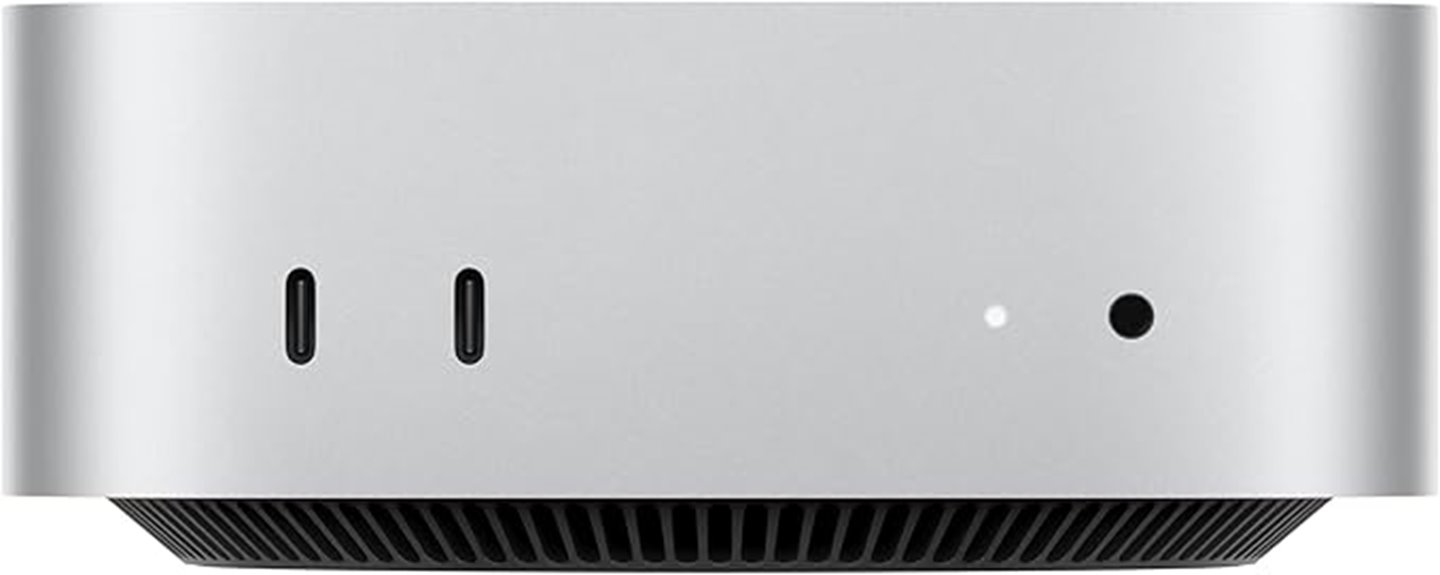
Designed for creative professionals seeking a compact yet powerful workstation, the 2024 Apple Mac mini with M4 chip delivers impressive performance in a tiny footprint. Measuring just 5 inches square and weighing 1.5 pounds, it fits easily next to monitors or in tight spaces. Its sleek aluminum design is portable and space-efficient, with extensive connectivity, including Thunderbolt 4, HDMI, Ethernet, and USB-C ports—though USB-A ports are gone. Powered by the M4 chip, it offers a 10-core CPU, 10-core GPU, and Neural Engine, boosting AI tasks, video editing, and multitasking. Quiet, energy-efficient, and supporting multiple high-res displays, it’s a versatile choice for home studios.
Best For: creative professionals and power users seeking a compact, high-performance desktop capable of handling demanding tasks and multiple high-resolution displays.
Pros:
- Compact, lightweight design that easily fits in tight spaces or next to monitors
- Powerful M4 chip with improved CPU, GPU, and AI performance for creative workflows
- Quiet operation and energy efficiency, maintaining cool temperatures during intensive use
Cons:
- USB-A ports are no longer available, requiring adapters for older peripherals
- Power button placement at the bottom may be less intuitive for some users
- Base model’s 16GB memory might limit performance in very demanding or multitasking scenarios
Apple Mac mini Desktop Computer with M4 Pro chip
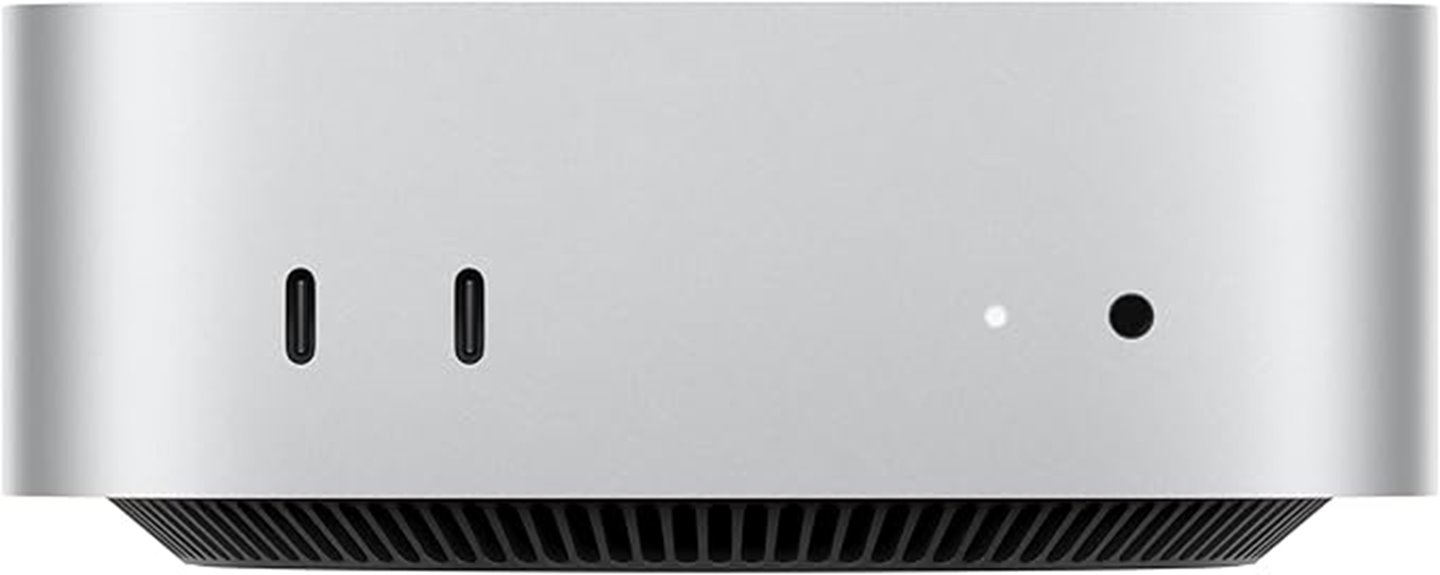
For home studio workstations that demand powerful performance in a compact space, the Apple Mac mini with M4 Pro chip stands out. Its small footprint—just 5 inches square—and lightweight design make it easy to place anywhere. The M4 Pro’s 12-core CPU, 16-core GPU, and Neural Engine deliver about 20% faster processing than previous models, perfect for demanding tasks like video editing and music production. With up to 48GB of unified memory and fast SSD options, it handles multitasking effortlessly. Support for multiple high-resolution displays, quiet operation, and energy efficiency make it ideal for a professional, space-saving studio setup.
Best For: professionals and creatives seeking a compact, high-performance desktop for demanding tasks like video editing, music production, and multitasking in a space-efficient setup.
Pros:
- Small, lightweight design fits easily into any workspace or studio environment
- Powerful M4 Pro chip with fast CPU, GPU, and Neural Engine for demanding professional workloads
- Supports multiple high-resolution displays and quiet, energy-efficient operation
Cons:
- Limited ports requiring adapters or hubs for USB-A devices
- Power button location on the bottom may be less intuitive to find
- Base model’s memory and storage configurations may limit intensive multitasking or large file projects
Factors to Consider When Choosing a Mac Mini for Home Studio Workstations
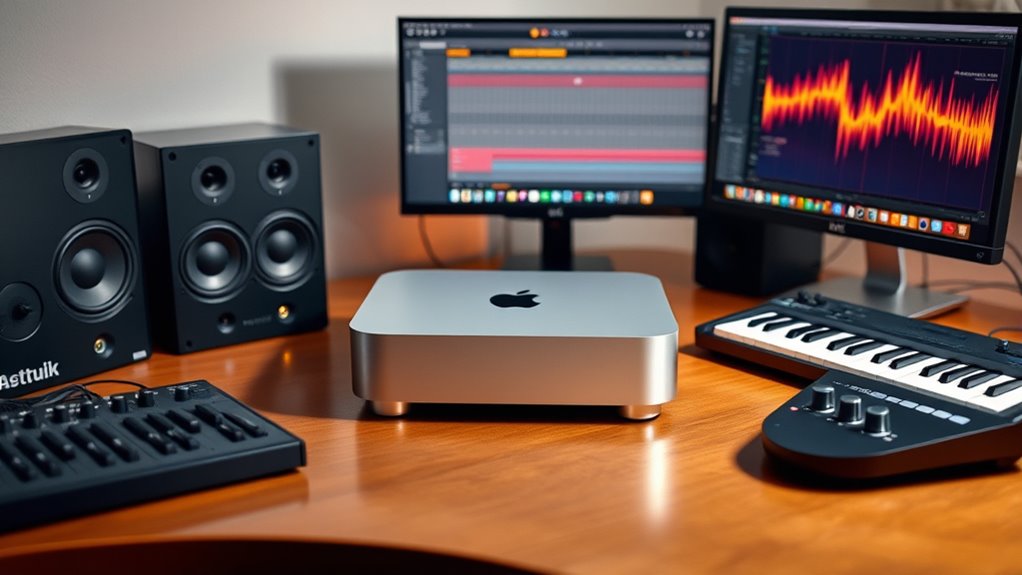
When selecting a Mac Mini for your home studio, I recommend considering your processing power needs, as this impacts how smoothly your software runs. You should also evaluate the memory, storage options, and connectivity features to guarantee your setup is efficient and future-proof. Finally, check compatibility with your software and external displays to avoid any surprises down the line.
Processing Power Needs
Choosing the right Mac Mini for a home studio hinges largely on its processing power, which directly affects how smoothly your audio and video projects run. Higher processing power guarantees demanding editing workflows are handled without lag or crashes. Multi-core CPUs, like 10-core or 12-core options, markedly boost multitasking, rendering times, and overall performance. The choice between M4 and M4 Pro chips impacts CPU speed, with the Pro offering up to 20% faster processing for intensive tasks. Adequate processing capability also allows for real-time monitoring and mixing without latency issues, vital during complex sessions. Upgrading to models with more cores or higher clock speeds not only improves current performance but also future-proofs your setup for expanding projects and evolving software requirements.
Memory and Storage Capacity
Having enough memory and storage is essential to guarantee your home studio runs smoothly, especially when working with large audio or video files. I recommend at least 16GB of RAM for seamless multitasking, though 24GB or more is better for demanding projects. Adequate memory prevents lag during editing and mixing sessions. Storage capacity is equally important; I suggest a minimum of 512GB to store project files, samples, and media without constantly relying on external drives. Many Mac minis allow you to upgrade to larger SSDs, which offers flexibility as your storage needs grow. Higher RAM and faster SSD options lead to quicker data access, less lag, and smoother performance during intensive tasks. Investing in ample memory and storage guarantees your workflow remains efficient and frustration-free.
Connectivity Options
Selecting a Mac mini with the right connectivity options is indispensable for a smooth home studio setup. You’ll want sufficient ports like Thunderbolt 4, HDMI, and USB-C to connect audio interfaces, external drives, and MIDI controllers simultaneously. High-speed Ethernet (up to 10Gb) is fundamental for stable streaming and transferring large files, guaranteeing your workflow remains uninterrupted. A headphone jack and multiple audio outputs are critical for monitoring and mixing. It’s also important to verify compatibility with your existing peripherals, especially since newer Mac minis lack USB-A ports—adapters may be necessary. Finally, consider support for multiple external displays, including 6K or 8K resolutions, to match your visual workstation needs. These connectivity options ensure a versatile, efficient, and reliable studio environment.
External Display Support
When setting up a home studio with a Mac mini, it’s important to think about how you’ll connect multiple external displays. The Mac mini supports up to three displays simultaneously—two 6K screens via Thunderbolt and one 4K or 5K display through HDMI. This setup is ideal for creative workflows that require high-resolution visuals and multitasking. Its Thunderbolt 4 and HDMI ports offer versatile options, supporting a wide range of resolutions and configurations. Support for DisplayPort 2.1 through Thunderbolt enables connecting ultra-high-resolution monitors, including 8K displays. This flexibility makes the Mac mini a strong choice for professional creators needing crisp visuals, smooth HDR content, and the ability to handle demanding visual tasks across multiple screens.
Software Compatibility
Choosing the right Mac mini for your home studio depends heavily on software compatibility. I recommend verifying that your digital audio workstation (DAW) or music production software runs smoothly on macOS, as most are optimized for it. Also, check if your creative tools like Adobe Creative Cloud, Final Cut Pro, or 3D rendering programs support the macOS version your Mac mini uses. If your workflow relies on hardware acceleration or specific plug-ins, ensure they are compatible with the Apple Silicon M4 or M4 Pro chips. Don’t forget to confirm that any peripheral or audio driver software works seamlessly with the hardware and OS. In the end, assess whether the Mac mini’s RAM and storage can handle large project files or multi-track sessions, making sure your software runs efficiently without bottlenecks.
Noise and Cooling
Since software compatibility often depends on the Mac mini’s hardware and thermal management, it’s worth noting that these machines operate quietly thanks to their efficient design. The M4 and M4 Pro chips are power-efficient, generating minimal fan noise even when under heavy load. The compact aluminum chassis helps dissipate heat effectively, keeping temperatures low during intensive tasks. This enhanced cooling prevents thermal throttling, ensuring consistent performance during long studio sessions. The low noise levels contribute to a distraction-free environment, which is vital for audio recording and mixing. Additionally, the energy-efficient architecture of Apple Silicon reduces heat output, allowing for a quieter workspace without the need for extra cooling equipment. Overall, these features make Mac minis ideal for a quiet, cool, and productive home studio.
Port Accessibility
The placement and availability of ports on the Mac mini are crucial considerations for setting up a home studio workstation. Ports are mainly on the front and back, including Thunderbolt 4, HDMI, USB-C, and Ethernet, which influences how easily I can connect devices depending on my workspace layout. The removal of USB-A ports means I need adapters or hubs for older peripherals, adding extra steps. Additionally, the power button’s location at the bottom can make it less intuitive to access quickly. With limited ports, I must prioritize essential connections or invest in hubs for expanded connectivity. To maximize convenience, I find it best to place the Mac mini within easy reach, especially for frequently used ports like USB-C and HDMI.
Budget Considerations
Budget considerations play a crucial role in selecting the right Mac mini for a home studio setup. First, I recommend defining your budget range, since higher-spec models with more storage can get expensive quickly. It’s essential to balance the cost of upgrades like additional RAM or SSD storage against your actual performance needs, avoiding overspending on features you may not use. Think about the long-term value; choose a configuration that can handle future software updates and expanding workload demands. Keep in mind that accessories such as adapters or hubs may add to your overall costs, especially if your chosen Mac mini lacks certain ports. Ultimately, set a budget aligned with your intended use—whether casual or professional—to make a smart, sustainable investment.
Frequently Asked Questions
How Does the M4 Pro Chip Improve Audio Processing Capabilities?
The M4 Pro chip considerably boosts my audio processing by offering faster, more efficient performance. It handles multiple tracks and plugins seamlessly, reducing latency and improving real-time editing. With its advanced neural engines, I notice smoother audio effects and quicker rendering. Overall, the M4 Pro makes my studio work more reliable, responsive, and capable of managing complex projects without hiccups, elevating my creative workflow to new levels.
Are External GPUS Compatible With the Latest Mac Mini Models?
Think of connecting an external GPU to a Mac Mini like adding a turbocharger to a car. With the latest models, you can use Thunderbolt 3 or 4 ports to connect external GPUs, making your system more powerful for creative tasks. I’ve found that compatibility is quite good, especially with Thunderbolt-supported enclosures. Just remember, not all external GPUs are plug-and-play, so check the specs before you buy.
What Are the Best Storage Options for Large Sample Libraries?
If you’re working with large sample libraries, I recommend using an external SSD for storage. Thunderbolt 3 or 4 drives offer fast read/write speeds, which keep your workflow smooth. I personally prefer SSDs over traditional HDDs because they load samples quicker and reduce latency. For maximum performance, consider RAID configurations if you need extra speed or redundancy. This setup helps me stay efficient and creative without storage bottlenecks.
Can the Mac Mini Handle Real-Time Audio Mixing Without Latency Issues?
Yes, the Mac Mini can handle real-time audio mixing without latency issues, especially if you opt for the higher-end models with more RAM and faster processors. I’ve found that using a good audio interface and optimizing system settings also helps minimize latency. Overall, it’s a solid choice for smooth, real-time mixing, making it perfect for home studios where reliable performance is essential.
How Do I Optimize Cooling for Extended Studio Sessions?
If you think cranking your Mac Mini for hours on end won’t heat things up, think again. I optimize cooling by placing my Mini in a well-ventilated area, using a cooling pad, and ensuring airflow isn’t blocked. Regularly cleaning dust from vents helps too. Bottom line: give your mini some breathing room, and it’ll keep cool enough to handle marathon studio sessions without breaking a sweat.
Conclusion
So, whether you choose the sleek power of the M4 or the mighty M4 Pro, your Mac mini can become the heartbeat of your creative studio. Think of it as your trusty sidekick, ready to turn ideas into reality with speed and grace. Pick the one that best fits your needs, and watch your home studio transform into a powerhouse of endless possibilities. Your next great project is just a click away!



